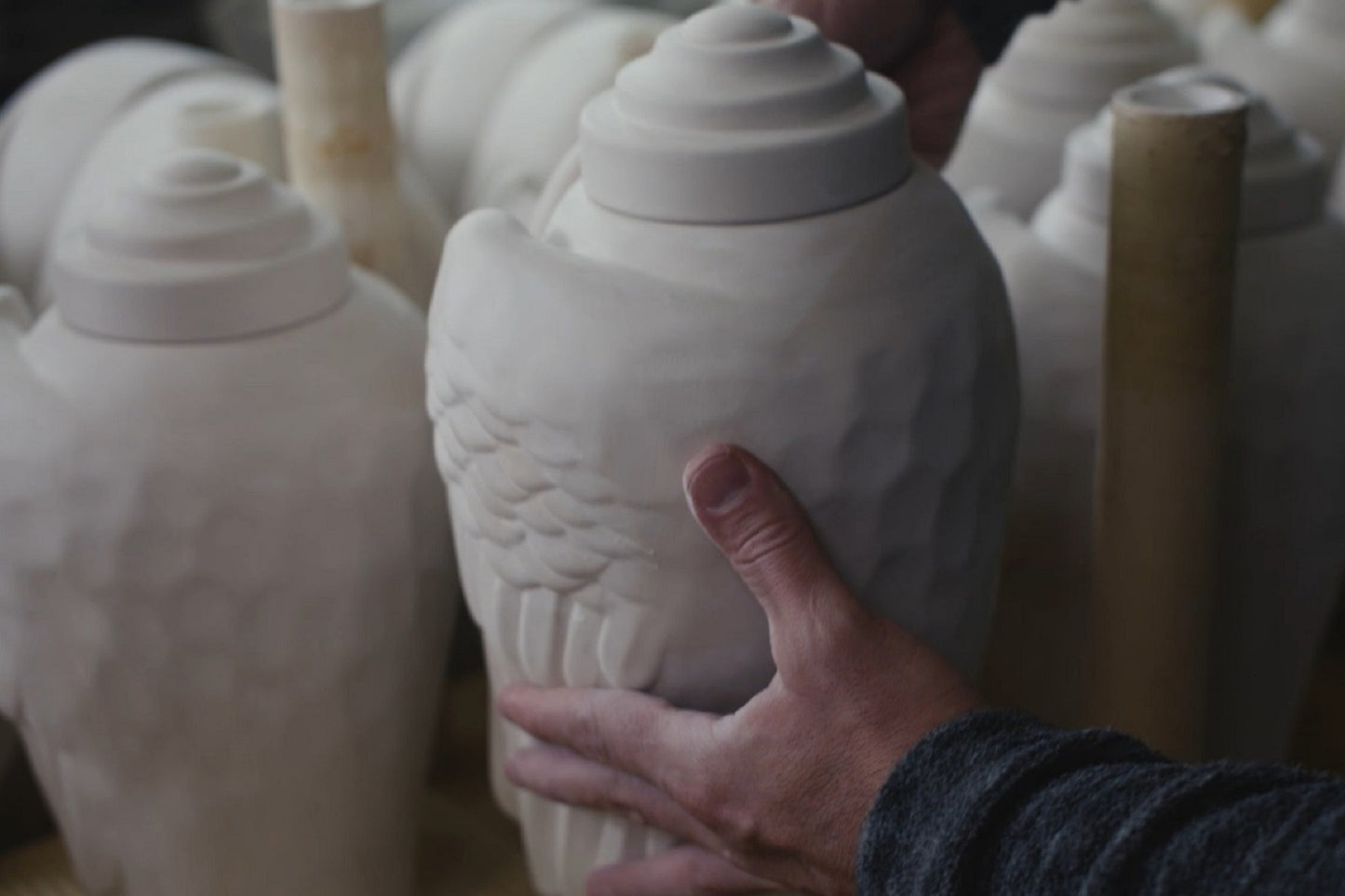
The process of making a ceramic urn for ashes (keepsake, or other high-quality ceramic product) is labor-intensive and elaborate, following a number of procedures that include mainly handwork. Producing the perfect ceramic urn for ashes requires knowledge, experience and dedication. It is something that our artisans and professionals possess. So, what are the steps of making a Pulvis Art Urn?
Conceptual Thinking and Symbolism
Designed exclusively by one of the most renowned Bulgarian contemporary artists, Alexander Yuzev, our cremation urns for ashes are a mixture of rich symbolism, modern design and conceptual thinking.

Urns for ashes by Pulvis Art Urns
We start by discussing thoroughly each idea that Alexander has about a future product, usually connected with powerful and meaningful things like life, death, art, nature and religion. Once the team reaches consensus on the symbolic meaning and the purpose of it, Alex starts drawing. And he is good at it.

Aleksandar Yuzev - Conceptual Artist in Pulvis Art Urns
Sketching is a number one rule when it comes to designing and developing our cremation urns, as it helps us visualize each line and feature the urn or the keepsake will have.

The Passage - Aquarelle Painting by Pulvis Art Urns
Once Aleksander is ready with the ideas on paper, we sit and discuss them with the sole purpose of choosing the best. When the right shape and design is agreed on, we proceed to modeling the memorial.
Shape & Form
Modelling is one of the most, if not the most, critical stages of creating a ceramic urn or keepsake for our portfolio.

Handmade Urn by Pulvis Art Urns. Clay model in progress.
Michelangelo once said: “The sculpture is already complete within the marble block, before I start my work. It is already there. I just have to chisel away the superfluous material.” Following the philosophy of that famous quote, Aleksander, softly chisels out the clay, until the priorly sketched shape is done.

Handmade Urn by Pulvis Art Urns. Clay model in progress.
Working carefully over each detail, sometimes modelling a new memorial urn takes months. Starting over and over, until he achieves the perfect shape, that is rarely identifiable as cremation urn, but rather as a piece of art.
Once the shape is ready to become an urn or keepsake, it is moved from the atelier to our manufacturing center, where it will be used to make molds.
Perfection To The Smallest Detail
Once we are ready with the original clay model, our next step is to think how it can be replicated and prepared for mass production. The entire production process is conducted by a team of specialists, which are supervised by our production manager Mihail. The numerous sculptures, embellishing many Bulgarian cities are a testimony for his vast experience.
Century-old gestures and know-how, passed down from generation to generation are what it takes to achieve perfection in each process. Mastering various techniques, like pottery wheel throwing, sculpting and carving is at the heart of every product we make.

Mastering various techniques, like pottery wheel throwing, sculpting and carving is at the heart of every product we make.
The first step of creating a mold is to make a gypsum shell of the model, by gently applying layers of liquid gypsum over the clay. Once they get dry, we have the gypsum shell ready for work. The shell’s only role is to help us make an original gypsum model of the cremation urn, which is then refined and used for making the molds.

A gypsum model of "Aquilae" large urn for ashes.
As molds are also made from gypsum, which is not very durable, they can only be used a certain number of times, before becoming inefficient. That is why we have to have to multiply them in the very beginning.

Gypsum molds for ceramic urns.
This is the moment when the so-called "matrix" comes to the rescue. Basically, matrixes can be defined as molds for the gypsum molds.
The Magic of Ceramics
Casting is a delicate and very labour-intensive process. First, we have to make sure that the slip (mixture of clay and/or other materials suspended in water) is good enough for the quality of our products. For our clay and glazes, we use only certified suppliers, who can be trusted to provide only the finest materials.

The process of casting a ceramic urn for ashes.
We can only start casting, when the slip is mixed, heated and good for work. The process requires the mold to be filled to the top and left to absorb some of the slip. As gypsum has the property of absorbing moisture it helps in the forming of a dry outer layer in the shape of the mold. The remaining material is drenched into a tank, where it can be heated and used again.

Urns, ready to be fired in the kiln. Photo by Pulvis Art Urns.
Later, the mold is left for a couple of hours so the slip can fully dry. Once it is done, we can remove the mold and gently pull out the formed shape. The shape is then left to fully dry and harden for a couple more hours, before it goes for firing.
The Test of Fire
We double fire our products on very high temperatures – almost 900°C (1650°F) the first time and then, after glazing, a second time on approximately 1200°C (2200°F). This makes them extremely strong and durable to external atmospheric conditions.
Firing in the kiln - a key moment, that our cremation urns go through twice. As the artists say, ceramics is alive and it is in the kiln where the success of each handmade piece is judged.

The test of fire. Photo by Pulvis Art Urns
So, once the first firing is ready, each and every one of our products goes for handmade touch.

Gently polishing an unglazed ceramic urn part, after the first firing.
For approximately ten to fifteen minutes per product, all the details get shaped to perfection by Mihail and his team. Once the product is shaped, it gets cleaned by high pressure air flow and it is ready for glazing.
Masters of Color
The glazing process is extremely delicate, depending on numerous factors like time, smoothness of the glaze and firing time. Pulvis Art Urns has a rich portfolio of glazes, that includes more than 40 color variations.

Glazing a ceramic urn for ashes.
Once submerged and glazed, the urns go back to the furnace for a second firing, this time at 1200°C. Reaching this temperature for several hours and then cooling, the process takes nearly 14 hours.
Quest For Excellence
Quality check is a priority for us and each one of our urns has to pass it. We inspect every detail, right after the cremation urn gets out of the furnace – abnormalities in the glaze, defects of the shape, weight, capacity, etc.
The pieces are selected not only according to technical criteria (absence of defects) but also according to aesthetic considerations, paying full respect to the creative team’s intentions.

Since 2020 Pulvis Art Urns is certified according to ISO - 9001, ISO - 1400 and ISO - 45001 standarts.
We strive to get as close as possible to our original products (on the photos) and we manage to do it in 95% of the time. However, as it is with every production process, especially in ceramics, the final result may have slight variations in color or shape, which is not necessarily bad, as it makes each urn truly unique.
Shapes of Spirit
From artist's inspiration, through glazing and firing, all the way to the packaging, Pulvis Art Urns team is dedicated in creating not just handmade urns, but Shapes of Spirit.
Excellence is also applied in the packaging, customized to the individual features of each piece in order to ensure that it reaches its final destination safely and in perfect conditions.
Packing our products is the last, but not least, very important step. We do this with extreme caution and attention to the detail, as we strive to pack each of our products gently and with the needed honor towards our clients.
From conceptual sketch drawing to the hands of the final customer, our craftsmanship and passion towards the whole process is what makes Pulvis Art Urns more than ordinary cremation urns for ashes. It is truly our way to help families honor the memory of their loved ones through art!
Join us in helping families honor the memory of their loved ones and pets through art!
Our Affiliate Program is now available at https://www.pulvisurns.com/pages/affiliate-program-by-pulvis-art-urns
